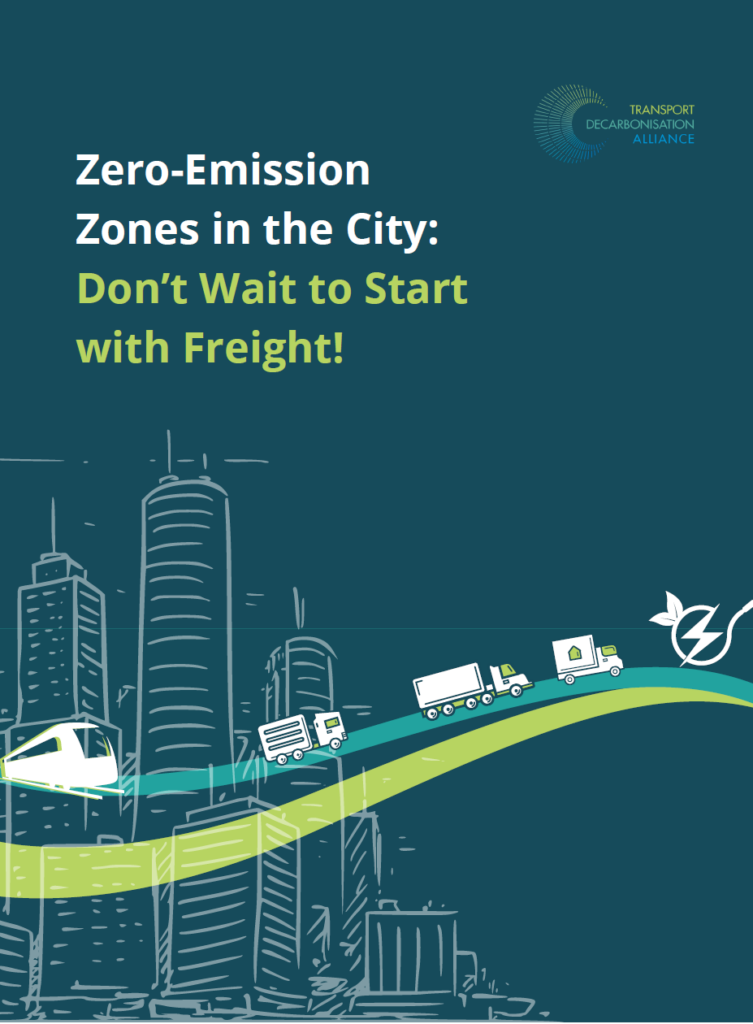Accelerating Freight Decarbonization
A Guide to Zero-Emission Zones in Cities
The Transport Decarbonisation Alliance (TDA) is a collaboration among countries, cities, regions and companies with the goal of accelerating the global transformation of the transport sector towards a net-zero emission mobility system by 2050. CLEE is actively supporting California Air Resources Board (CARB) with its TDA presidency through research and strategic coordination. Together with various partners (listed below), CLEE has co-authored the TDA’s newly launched How to Guide- Zero-Emission Zones in the City, a guidebook for stakeholders to reduce freight emissions in city centers.

With the increasing demand for goods and the expansion of global trade, freight transportation has experienced a significant surge. Ocean-going ships transport nearly three-quarters of the world’s cargo, but heavy-duty road vehicles contribute to the majority- 65% of emissions from freight. As economies grow and supply chains become more complex, the need to transport goods across various distances has intensified. Although trucks make up less than 4% of vehicles on the road in the US, they are accountable for approximately 29% of road transport’s CO2 emissions. Additionally, medium and heavy-duty trucks can have a significant impact on the health of low-income communities. These trucks often operate in densely populated areas, which are frequently home to low-income communities. The emissions from these trucks, such as particulate matter & nitrogen oxides, can contribute to poor air quality in these communities.
Zero-Emission Zones for Freight (ZEZ-Fs) are designated areas in cities exclusively allowing zero-emission delivery and freight transport vehicles. These zones effectively reduce pollution and improve the quality of urban life. By implementing ZEZ-Fs, cities can expedite the decarbonization of their transport systems while simultaneously promoting optimized freight services and distribution models. Rotterdam, Netherlands serves as an example with its existing Low Emission Zone that affects freight vehicles. To further advance sustainable logistics, Rotterdam signed the Zero Emission City Logistics Covenant (ZECL) in December 2020, demonstrating a collective commitment to establishing a zero-emission zone for city logistics (ZECL-zone). Rotterdam has set ambitious targets and developed a transparent timeline, aligning this program with its overall strategy for achieving climate goals and national environmental and economic initiatives.
The guidebook highlights essential steps for implementing ZEZ-Fs in cities, including:
- Stakeholder Engagement: Successful implementation of ZEZ-Fs involves engaging stakeholders and gaining their support. Rotterdam, Copenhagen, and Oslo exemplified this approach by fostering open and cooperative dialogues with suppliers, both large and small, through the BuyZET Project. This inclusive procurement process ensured smooth implementation of ZEZ-Fs in these cities.
- Target definition and alignment: Clearly defining targets and aligning them with regional, national, and international goals is crucial for effective ZEZ-F implementation. Identifying the specific issues that ZEZ-Fs aim to address, establishing a baseline, and setting clear objectives, goals, and key performance indicators (KPIs) against the existing baseline are vital steps. Moreover, it is important for regional or national governments to prioritize meeting the targets set by the Paris Agreement, supporting cities in their efforts. The Netherlands’ Green Deal serves as a successful example, with 30-40 cities committing to implementing ZEZ by 2025. This target has been incorporated into the National Climate Agreement, a binding law that ensures political commitment to implementation.
This comprehensive guide is designed to assist urban planners, transport officials, freight operators and other stakeholders in navigating the complex landscape of urban freight and developing ZEZ-Fs. By adopting ZEZ-Fs, cities can make significant contributions to decarbonization, reduced congestion, improved delivery efficiency, enhanced air quality, and addressing environmental justice concerns. The guide draws inspiration from cities worldwide, regardless of size, showcasing diverse examples of successful ZEZ-F implementation. For instance, Kevadia in India has become the country’s first electric vehicle city, with a restricted area where only electric vehicles are allowed. The region has already permitted 50 electric rickshaws within the zero-emission zone, with a focus on providing opportunities for women drivers, promoting equity in this vehicle transition.
We trust that this guide offers practical suggestions and initial steps to help city officials, transportation planners, and consultants embark on their ZEZ-F implementation journey.
Download the report here: How to Guide- Zero-Emission Zones in the City
Authors: Verena Ehrler, Rosemarie Cramer, Henrik Gudmundsson, Catherine Ittner, Vishant Kothari, Katherine Lopez, Giacomo Lozzi, Robyn Marquis, Sandra Rothbard, Shruti Sarode, Hamilton Steimer, Tu My Tran, Raffaele Vergnani & Lulu Xue
Partners: CARB, CALSTART, C40, CONCITO, Freight Matters, ICLEI, Transport Research Lab, POLIS, World Resources Institute






Reader Comments